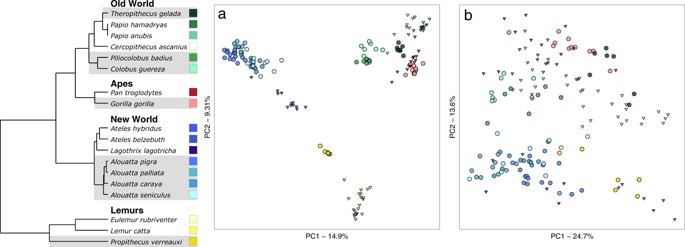A) Host physiology outweighs dietary niche in primate gut microbiomes
To test the influence of host dietary niche on the mammalian gut microbiome, we utilized 16S rRNA gene amplicon sequencing and shotgun metagenomics to compare gut microbiome across 18 species of wild non-human primates, representing the full range of gut morphological specializations.

We found that the influence of host phylogeny on gut microbial composition and function is stronger than that of host dietary niche, and this influence stems from differences in host physiology. Mammalian gut microbiome plasticity in response to dietary shifts over the lifespan of an individual host as well as over the evolutionary history of a host species is constrained by host physiological evolution. Based on this study, the gut microbiome cannot be isolated from host physiology when describing host nutritional strategies and the emergence of host dietary niches in the future.
B)Variable responses of human and non-human primate gut microbiomes to a Western diet
As humans have evolved, our microbiomes have followed. Unique diet and physiology most likely lead to different host-gut microbe interactions in humans when compared to non-human primates. In this study, we used 454 titanium pyrosequencing and predictive metagenomics (PICRUSt) to compare the gut microbiota of humans and African green vervets (Chlorocebus aethiops sabaeus), a model primate. Samples were taken from humans and vervets consuming both a Western and non-Western diet.
When both humans and the African green vervet were fed a high-protein, high-fat Western diet, their microbiomes reacted differently. Humans exhibited higher relative abundance of Firmicutes and lower relative abundance of Prevotella, while vervets demonstrated the opposite pattern. Using predictive genomics, we found an increased relative abundance of genes associated with carbohydrate metabolism in the microbiomes of humans who were eating only a Western diet.

Thus, the human gut microbiota has unique properties resulting from evolutionary changes in human diet and physiology.
C) The gut microbiota can compensate for seasonal diet variation in wild black howler monkeys
For most mammals, including nonhuman primates, diet composition varies temporally in response to differences in food availability. Because diet influences gut microbiota composition, it is likely that the gut microbiota of wild mammals varies in response to seasonal changes in feeding patterns. Such variation may affect host digestive efficiency and, ultimately, host nutrition.
We investigated the temporal variation in diet and gut microbiota composition and function in two groups of wild Mexican black howler monkeys (Alouatta pigra) in Palenque National Park, Mexico. Temporal changes in the relative abundances of individual bacterial taxa were strongly correlated with changes in host diet. Howlers exhibited increased microbial production of energy during periods of reduced energy intake from food sources.
Because we observed few changes in howler activity and ranging patterns during the course of our study, we propose that shifts in the composition and activity of the gut microbiota provided additional energy and nutrients to compensate for changes in diet. Energy and nutrient production by the gut microbiota appears to provide an effective buffer against seasonal fluctuations in energy and nutrient intake for these primates and is likely to have a similar function in other mammal species.